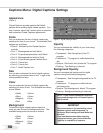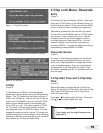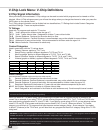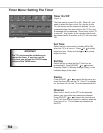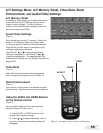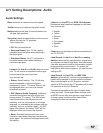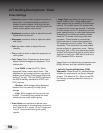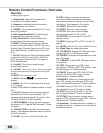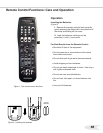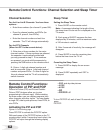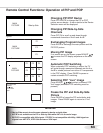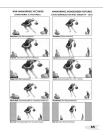
In This Section . . .
58
A/V Setting Descriptions: Video
Video Settings
• Contrast provides a slider to adjust the white-to-
black level. Low contrast shows a variety of
shades in darker images, while high contrast
shows darker images more uniformly black and
makes colors appear more vibrant.
• Brightness provides a slider to adjust the overall
brightness of the picture.
• Sharpness provides a slider to adjust the detail
and clarity.
• Color provides a slider to adjust the color
intensity.
• Tint provides a slider to adjust the proportion of
red to green.
• Color Temp (Color Temperature) allows you to
adjust how white images are displayed. Your
choices are:
— Low 6500K or Low (for DTV): White
images will have a warm cast to them. This
adjustment is an average and can vary due to
ambient room lighting, video scene brightness
and the TV’s age. The Low 6500K represents
the 6500K industry standard for NTSC (non-
DTV) pictures.
—Medium: White images will be balanced
between the Low (warm) and High (cool)
settings.
—High: White images will have a cool cast
to them. This setting may provide the most
realistic picture under bright lighting.
• Video Noise use reduction to reduce minor
noise (graininess) in the broadcast received on
Ant-A and Ant-B or Inputs 1-5 and Component
1 and 2. Use standard with good quality
signals.
• Image Type maximizes the original camera
media: Video or Film. Video media uses a
video camera and is created at 30 frames per
second. Film media uses a lm camera and
is created at 24 frames per second. Examples
of Video media are live TV broadcast such as
news, special events, or video taped programs.
Examples of lm media are motion pictures,
made-for-TV movies, and many prime time
programs. Filmed media is converted by
the broadcaster or home video company to
30 frames per second to match TV or video
standards. This conversion can leave subtle
picture artifacts or conversion errors. Setting
the Image Type to Film can reduce the picture
artifacts and improve the picture quality, when
viewing a movie from a 480i device such as a
VCR, standard DVD or antenna.
Image Type is not effective for progressive scan
(480p) devices, and high denition signals.
• Velocity Scanning Modulation (VSM)
Sharpness When turned On, selected image
outlines are emphasized, resulting in sharper
images. The default is On. When turned Off,
the velocity scanning modulation function is
prevented.



